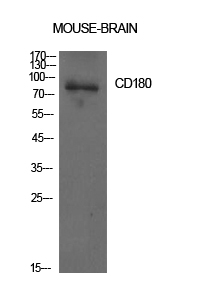CD180 Polyclonal Antibody
- Catalog No.:YT5629
- Applications:WB;ELISA
- Reactivity:Human;Mouse;Rat
- Target:
- CD180
- Gene Name:
- CD180
- Protein Name:
- CD180 antigen
- Human Gene Id:
- 4064
- Human Swiss Prot No:
- Q99467
- Mouse Gene Id:
- 17079
- Mouse Swiss Prot No:
- Q62192
- Immunogen:
- Synthesized peptide derived from CD180 antigen at AA range: 221-270
- Specificity:
- CD180 Polyclonal Antibody detects endogenous levels of CD180 protein.
- Formulation:
- Liquid in PBS containing 50% glycerol, 0.5% BSA and 0.02% sodium azide.
- Source:
- Polyclonal, Rabbit,IgG
- Dilution:
- WB 1:500 - 1:2000. ELISA: 1:10000. Not yet tested in other applications.
- Purification:
- The antibody was affinity-purified from rabbit antiserum by affinity-chromatography using epitope-specific immunogen.
- Concentration:
- 1 mg/ml
- Storage Stability:
- -15°C to -25°C/1 year(Do not lower than -25°C)
- Other Name:
- CD180;LY64;RP105;CD180 antigen;Lymphocyte antigen 64;Radioprotective 105 kDa protein;CD180
- Observed Band(KD):
- 75kD
- Background:
- CD180 is a cell surface molecule consisting of extracellular leucine-rich repeats (LRR) and a short cytoplasmic tail. The extracellular LRR is associated with a molecule called MD-1 and form the cell surface receptor complex, RP105/MD-1. It belongs to the family of pathogen receptors, Toll-like receptors (TLR). RP105/MD1, by working in concert with TLR4, controls B cell recognition and signaling of lipopolysaccharide (LPS), a membrane constituent of Gram-negative bacteria. [provided by RefSeq, Jul 2008],
- Function:
- disease:Decreased expression of LY64 has been shown in systemic lupus erythematosus (SLE). The loss of LY64 is associated with B-cell activation and increased disease activity in SLE patients.,function:May cooperate with MD-1 and TLR4 to mediate the innate immune response to bacterial lipopolysaccharide (LPS) in B-cells. Leads to NF-kappa-B activation. Also involved in the life/death decision of B-cells.,similarity:Belongs to the Toll-like receptor family.,similarity:Contains 17 LRR (leucine-rich) repeats.,subunit:Binds to MD-1.,tissue specificity:Expressed mainly on mature peripherical B cells. Detected in spleen, lymph node and appendix. Not detected in pre-B and -T cells.,
- Subcellular Location:
- Cell membrane; Single-pass type I membrane protein.
- Expression:
- Expressed mainly on mature peripherical B cells. Detected in spleen, lymph node and appendix. Not detected in pre-B and -T cells.
- June 19-2018
- WESTERN IMMUNOBLOTTING PROTOCOL
- June 19-2018
- IMMUNOHISTOCHEMISTRY-PARAFFIN PROTOCOL
- June 19-2018
- IMMUNOFLUORESCENCE PROTOCOL
- September 08-2020
- FLOW-CYTOMEYRT-PROTOCOL
- May 20-2022
- Cell-Based ELISA│解您多样本WB检测之困扰
- July 13-2018
- CELL-BASED-ELISA-PROTOCOL-FOR-ACETYL-PROTEIN
- July 13-2018
- CELL-BASED-ELISA-PROTOCOL-FOR-PHOSPHO-PROTEIN
- July 13-2018
- Antibody-FAQs
- Products Images

- Western Blot analysis of mouse brain cells using CD180 Polyclonal Antibody. Antibody was diluted at 1:1000. Secondary antibody(catalog#:RS0002) was diluted at 1:20000
.jpg)
- Western Blot analysis of MOUSE-BRAIN cells using CD180 Polyclonal Antibody diluted at 1:1000. Secondary antibody(catalog#:RS0002) was diluted at 1:20000



